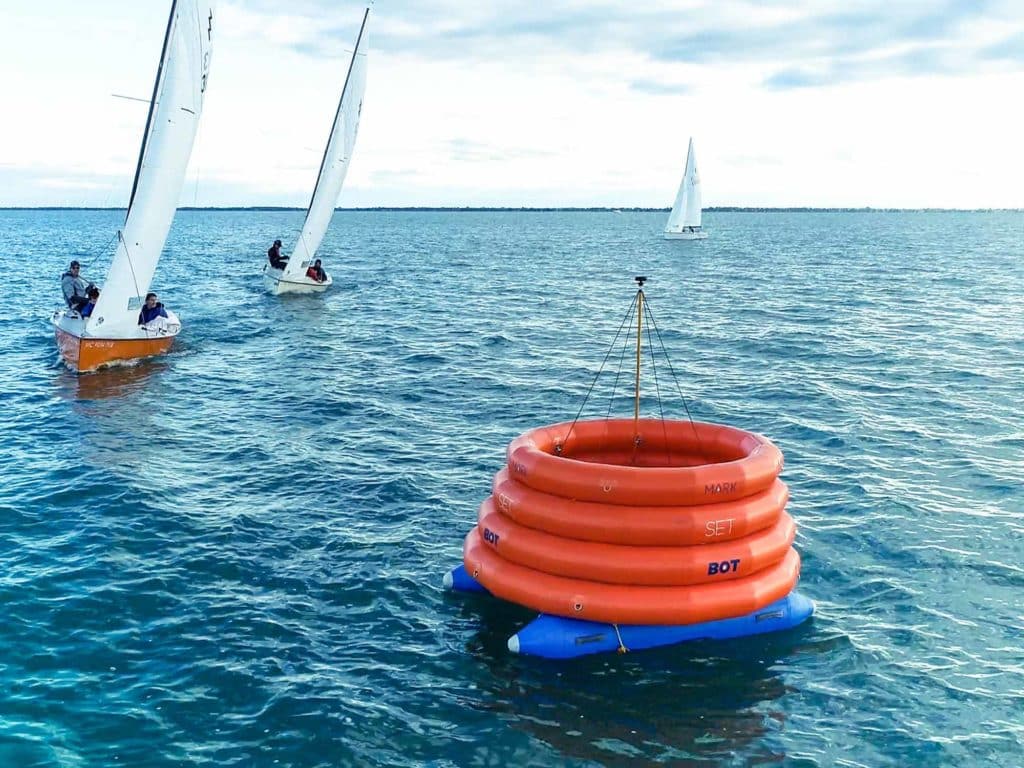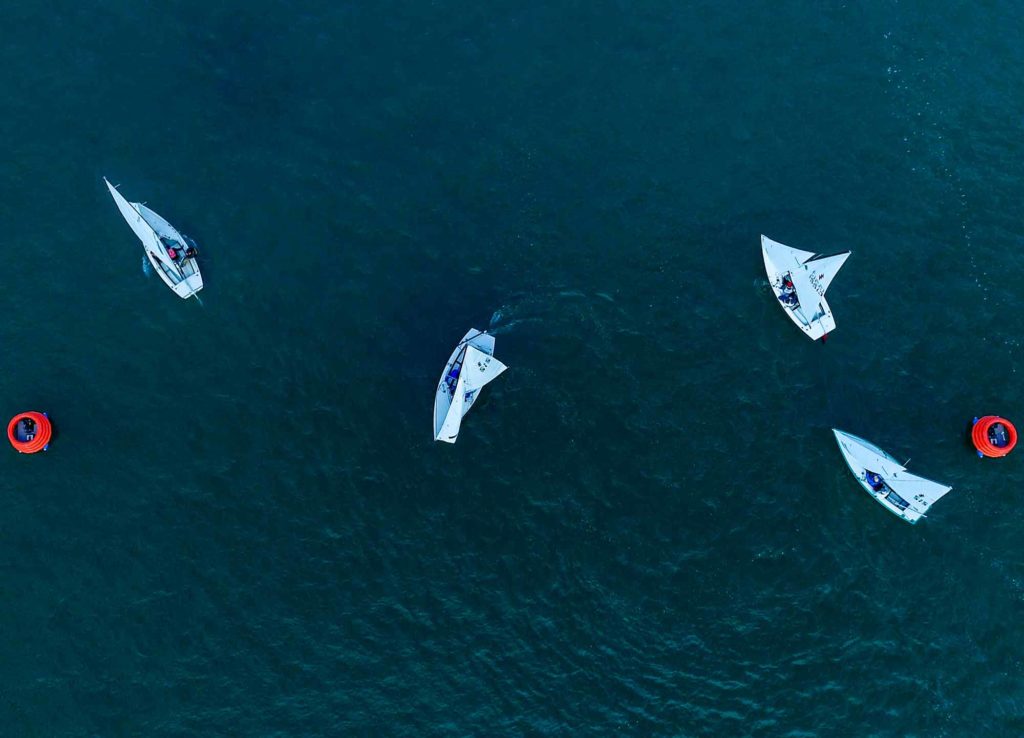
It’s a crisp late October Saturday at the Crescent Sail YC, on Michigan’s Lake St. Clair, and a small group of Lightnings are maneuvering around two oddly shaped, automated race marks, called Bots, that designate a starting line. Well to windward is another Bot. Just before the starting sequence begins, the competitor who is monitoring and communicating with the Bots gets a signal on his cellphone from the windward Bot that there is a 20-degree windshift. With the press of a button, the entire course, starting line and all, rotates so the windward mark is still dead to windward and the starting line is square to the wind. It takes less than a minute.
The starboard starting-line Bot begins the sequence, but at the start, one boat is over early. The Bot immediately sounds the OCS signal and promptly sends a message via VHF, cellphone and smart-watch to the over-early boat, and that boat restarts. Later, that same Bot records the finishes. Sound like science fiction? Not at all.
Welcome to Kevin Morin’s world. Morin, whose company, MarkSetBot, has been selling the Bots his company developed since 2015. Then, it signaled a major step in race management, giving race committees the ability to position and promptly reposition marks and be confident they’d stay in place, all without concern about water depth, waves or current. And, it succeeded. Now, five years later—a lifetime in the tech world—it’s at a whole new level with the introduction of MarkSetBot’s RaceOS system. “I think I can pretty safely say that we have run the first fully autonomous sailboat race in the world,” he says.
What does it take to run races without a race committee? There’s still some human activity involved. The day starts with a handful of sailors deploying the Bots, which means unplugging them from their chargers and either carrying them to the water (two people will work, but four is easier) or wheeling them with an Opti-sized dolly. One sailor is the designated course manager and routes the marks to the race area with a cellphone. Traveling at 4 knots, they arrive about the same time as the competitors. Once there, the weather mark begins recording wind direction and starts assembling a direction history. The course manager plugs that info into an app, which determines where to put the marks. Once confirmed, the marks move into position.
The starting sequence has an automated horn system activated with the simple press of a button on the app labeled “Start Sequence.” Each boat is equipped with a tracker, as are both starting Bots, and when the sequence begins the trackers are automatically activated. At 1 minute before the start, the trackers move into high-speed mode, which allows them to figure out when someone is OCS.

“It’s all done by GPS,” says Morin. “The trackers have cellular cards in them, so each boat has a cellular connection, as well as the two Bots. They’re all synced from a time standpoint, so then it becomes a math problem to determine which one has crossed the line early.” Finishes are done similarly. “It all happens in real time,” says Morin, “which means you can not only study how your boat and other boats did, but it enables people ashore to follow the racing as well.”
At the end of the day, the Bots are routed back ashore, and competitors pull them from the water and plug them back into their chargers so they’ll be ready for the next day of racing.
OK, I know what you’re thinking. This is all sounds great, but what if there’s a tech glitch, one of the Bots has a functional failure or . . . the list goes on and on. “We’ve gone through hundreds of scenarios,” says Morin, troubleshooting them and coming up with solutions.”
Some examples. What happens if the prop on the motor gets fouled by weeds and it can no longer thrust to remain in position? Says Morin, “Without an RC, the only option is to fix it yourself. So, you do.”
“Same with the safety boat issue. Most people are out there all the time without a safety boat. If you have a problem, there’s usually another competitor who can pitch in and help.”
But the big one is battery maintenance. “People have to remember to plug the charger in. To help with that, we developed a very aggressive alert system that sends you a message when you get below a certain level on the Bot batteries. Just a while back, a customer forgot to turn their Bots off, and I immediately got an alert, as did they, telling them to turn them off.” They’ve also built in redundancy systems for keeping the Bots in place—or “anchoring” them. “If the main communication module dies, you can’t tell the Bot to go to a new place, but it will stay where it is. The course may no longer be perfect, but it will remain functional.” To date, there are more than 100 clubs worldwide using Morin’s Bots, with about half of those in Europe.
While Bot prices are not inexpensive (north of $7,000 each) there is a lease-to-own program that puts them in reach of more clubs. And Morin has discovered that, especially for clubs running races multiple times per week, the Bots might be more cost-effective. “We checked with a whole bunch of clubs, and with five RC people, fuel consumption, wear and tear on the boats, maintenance, insurance—they’re spending anywhere from $150 to $500 a day. It’s a bit complicated to figure precisely, but it’s a way a lot of clubs had to start thinking about it.”
Where to from here? “Next year,” says Morin, “we’ll be at what we call ‘Level 5 Automation’, where you can not only do all the things we’re able to do with RaceOS, but you can also define your race area, auto-adjust the course size based on how boats perform, set up the course direction based on AI logic, and the Bots will start the race at a set time and change the course as necessary.”
About all that’s missing is an automatic Bot launching and retrieval system.









